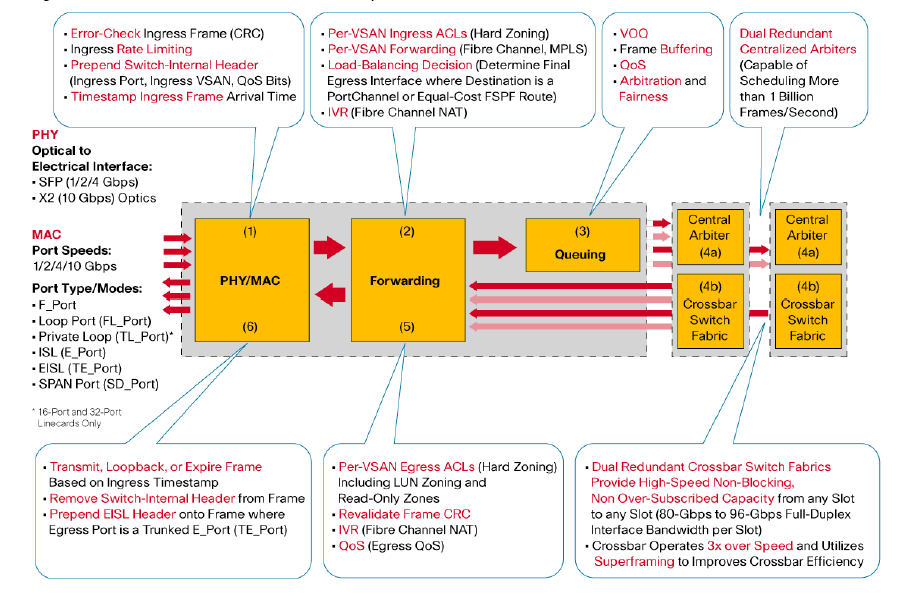Introduction
Cisco MDS 9000 family fabric switches are cost-effective, highly scalable, easy to install, and highly configurable Fibre Channel switches that are ideal for small to medium-sized businesses, along with departmental and remote branch offices needing intelligent storage area networks. With deployment options ranging from stand-alone, top-of-the rack, and blade switches for IBM BladeCenter and HP c-Class BladeSystem, the Cisco MDS 9100 Series Multilayer Fabric Switches provide customers with excellent flexibility, while maintaining consistent feature sets and management capabilities.
All Cisco MDS 9500 Series director switches are based on the same underlying crossbar architecture. Frame forwarding logic is distributed in application-specific integrated circuits (ASICs) on the linecards themselves, resulting in a distributed forwarding architecture. There is never any requirement for frames to be forwarded to the supervisor for centralized forwarding, nor is there ever any requirement for forwarding to drop back into software for processing—all frame forwarding is performed in dedicated forwarding hardware and distributed across all linecards in the system. All advanced features, including virtual SANs (VSANs), VSAN Trunking, Inter-VSAN Routing (IVR) including Fibre Channel Network Address Translation (FC-NAT), Cisco PortChannels (port aggregation), quality of service (QoS), Fibre Channel Congestion Control (FCC), Switch Port Analyzer (SPAN), and Remote Switch Port Analyzer (RSPAN) are implemented within the hardware-based forwarding path and can be enabled without any loss of performance or additional latency. All of these advanced features were built into the Cisco MDS 9000 Family ASICs from the beginning. Second-generation Cisco MDS ASICs augment these capabilities with the addition of class of service (CoS) and port bandwidth reservation capabilities, with more hardware capabilities to be enabled in future Cisco MDS 9000 SAN-OS Software releases.
Forwarding of frames on the Cisco MDS always follows the same processing sequence:
- Starting with frame error checking on ingress, the frame is tagged with its ingress port and VSAN, enabling the switch to handle duplicate addresses within different fabrics separated by VSANs.
- Following the frame tagging, input access control lists (ACLs) are used to enforce hard zoning.
- A lookup is issued to the forwarding and frame routing tables to determine where to switch the frame to and whether to route the frame to a new VSAN and/or rewrite the source/destination of the frame if IVR is being used.
- If there are multiple equal-cost paths for a given destination device, the switch will choose an egress port based on the load-balancing policy configured for that particular VSAN.
- If the destination port is congested or busy, the frame will be queued on the ingress linecard for delivery, making use of QoS policy maps to determine the order in which frames are scheduled.
- When a frame is scheduled for transmission, it is transferred across the crossbar switch fabric to the egress linecard where there is a further output ACL, and the VSAN tag used internal to the switch is stripped from the front of the frame and the frame is transmitted out the output port.

Figure 1 : Frame flow within Cisco MDS 9000 Family switches
Since the switches serve as the building-blocks for storage networks, glitches in its performance can cause the untimely collapse of your SAN, which in turn might result in significant delays in the delivery of the dependent end-user services and prolonged service outages. To avoid such adversities, eG Enterprise helps network administrators to continuously monitor the Cisco SAN switch.
